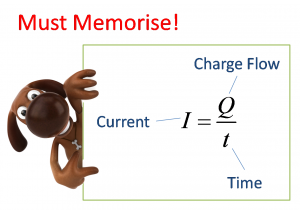Current
- An electric current I is a measure of the rate of flow of electric charge Q through a given cross-section of a conductor.
- In other words, current is the measure of how fast the charge flow through a cross-section of a conductor.
Direction of Current
- Conventionally, the direction of the electric current is taken to be the flow of positive charge.
- The electron flow is in the opposite direction to that of the conventional current.
- In a circuit, current flow from the positive terminal to the negative terminal.
- In a circuit, electrons flow from the negative terminal to the positive terminal.
Unit of Current
- The SI unit for current is the ampere (A).
- The current at a point is 1 ampere if 1 Coulomb of electric charge flows through that point in 1 second. Therefore, 1 A = 1C/s.
Example 1:
If 30 C of electric charge flows past a point in a wire in 2 minutes, what is the current in the wire?
Answer:
Charge flow, Q = 30C
Time taken, t = 2 minutes = 120s



